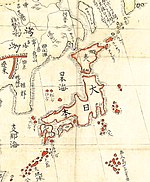Asuka period
Appearance
| History of Japan |
|---|
 |
The Asuka period (
The Asuka period is named after the Asuka region, about 25 km south to the modern city of Nara.
Timeline
[change | change source]- 538: Introduction of Buddhism from China via Korean peninsula[2]
- 593: Prince Shōtoku is regent for Empress Suiko[2]
- 600: Yamato state sends the first Japanese diplomatic mission to China[2]
- 607: Prince Shōtoku builds the Buddhist temple Hōryūji in Ikaruga.
- 645 (Taika 1): Emperor Kōtoku moves his capital from Asuka to Naniwa near the Bay of Osaka.[3]
- 645 (Taika 1): Taika Reform and the establishment of provinces[2]
- 672: Prince Ōama, later Emperor Temmu usurped the throne by winning the civil war (Jinshin no Ran) against Emperor Kōbun.
- 701 (Taihō 1): Code of Taihō was proclaimed.[2]
- 708 (Keiun 5): A mint was established in the province of Ōmi.[4] The mint made coins which are recognized as the first Japanese currency.[5]
- 710 (Wadō 3, 3rd month): Empress Gemmei established her new capital in Nara, which was known then as Heijō-kyō.[4]
Gallery
[change | change source]-
Wadōkaichin coin, minted starting in 708
Related pages
[change | change source]References
[change | change source]- ↑ Nussbaum, Louis-Frédéric. (2002). "Asuka-jidai" in Japan Encyclopedia, p. 59.
- ↑ 2.0 2.1 2.2 2.3 2.4 Hall. John Whitney. (1991). Japan: From Prehistory to Modern Times, p. 538.
- ↑ Brown, Delmer. (1979). Gukanshō, p. 266; Osaka City website: Archived 2009-03-06 at the Wayback Machine Osaka, history Archived 2007-11-06 at the Wayback Machine
- ↑ 4.0 4.1 Ponsonby-Fane, Richard. (1959). The Imperial House of Japan, p. 56.
- ↑ Japan Mint Museum Wado Kaichin Archived 2007-05-10 at the Wayback Machine. Retrieved 2012-4-29.
Other websites
[change | change source]![]() Media related to Asuka period at Wikimedia Commons
Media related to Asuka period at Wikimedia Commons
- Metropolitan Museum of Art, Asuka and Nara Periods
- Japan-guide.com, Early Japan

